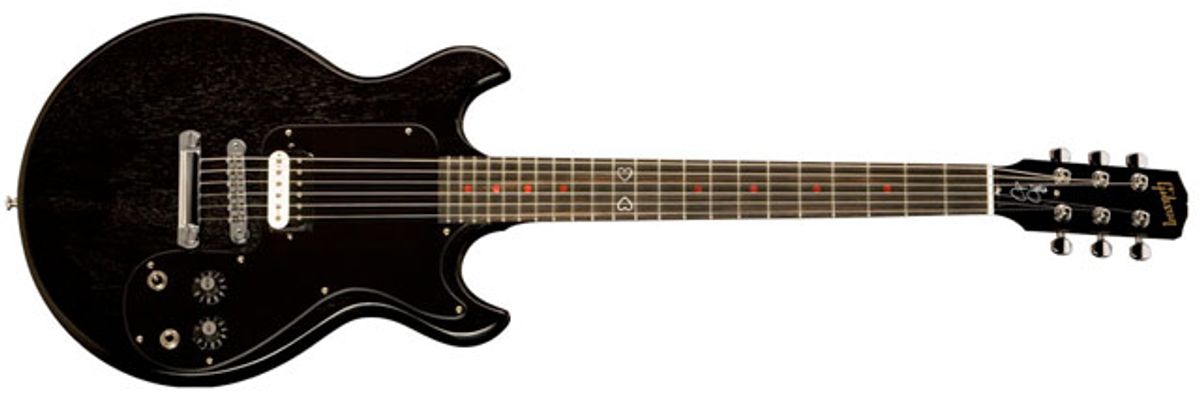
Joan Jett''s latest signature Melody Maker is a simple rock machine that''s built for chunky rhythms.
| Download Example 1 Clean |
|
| Download Example 2 Medium Dirt |
|
| Download Example 3 Metal |
|
| Download Example 4 Rock |
|
| Download Example 5 Rock |
|
| All clips recorded with the Gibson Joan Jett Blackheart guitar directly into Avid Pro Tools, using the Native Instruments Guitar Rig amp simulator. | |
The Joan Jett Blackheart Melody Maker from Gibson features a mahogany body, a quarter-sawn, rounded profile solid mahogany neck, ebony fingerboard with 12” radius and 22 jumbo frets, and mini Grover LP-style tuners. The Blackheart features one zebra coil Burst Bucker 3 pickup in the bridge position, one volume control and one tone control, both with black witch hat knobs. The toggle switch normally found on a Melody Maker is replaced with a sideways mounted kill switch, which Joan uses to turn the guitar off while singing.
First Impressions
The Blackheart sports great looks, with features that add a little refinement to the guitar. It has a satin ebony nitrocellulose finish, which is smooth to the touch and feels great—not too glossy or overstated. The fret inlays are bright red, and the 12th fret has mother-of-pearl inlay hearts lying end-to-end. To round out the custom features, Joan’s signature adorns the truss rod cover.
Picking up the guitar for the first time, I found it lightweight, comfortable and quite resonant when strummed unplugged. The smooth feel and worn-in texture of the neck is very comfortable, thanks to the satin ebony finish. It’s easy to see why this guitar fits Jett’s rhythm playing needs—it’s not too bulky, feels very solid, and you can crank out power chords with ease. The double cutaway allows easy access for chords all the way up the neck to the 19th position if you’re so inclined.
Though well-suited for rhythm playing, the Blackheart is probably not an ideal choice for extended lead playing. Some shredders may prefer a flatter or thinner neck as opposed to the rounded profile of this guitar neck, and folks with smaller hands might find it difficult play leads all night. However, beefiness of the neck does offer plenty of sustain, and the ebony fretboard produces a bold, clear tone.
Plugging In
The real fun is plugging in the Blackheart and letting it do what it does best—cranking out chunky power chords. I plugged it into a variety of amps, including a Marshall 1959RR head and Lead 1960 cabinet, an Egnater Tourmaster 4212, and a Fryette Memphis 30 combo, as well as a few amp simulators, all with plenty of overdrive and quickly learned that the Burstbucker 3 pickup is the real star of the show. This pickup really roared through every amp I put it through. The distorted tone offered punch, thickness, and clarity, and it was a nice mix of rumbling lows and singing highs that really cut through without being too harsh. The humbucker had plenty of crunch and sustain, making the guitar great for aggressive rhythm playing in punk, hard rock, or heavy metal. Backing off the drive on the amp, the guitar retained its thick tone that sounds great for classic rock or blues.
With a single humbuckers and no coil tap, the tonal options are not overwhelming. However, I was able to attain a bit warmer tone while playing leads by rolling down the tone knob all the way, which provided enough warmth to emulate a pickup in the neck position while maintaining a decent level of sustain and drive.
Switching to a clean sound with the EQ set flat on the amp, the clean tone required tweaking of the amp’s parameters to get the full, balanced sound that I was looking for. It’s not that the tone was too thin—I just prefer my clean tone a little fuller overall. The clean tone is definitely neutral, not twangy enough for a country sound, but not “bloomy” enough for the warm tone that you’d get from two humbuckers or a humbucker in the neck position. Since you’re not going to get many tonal options from the guitar itself, the adjustments need to be made on your amp and/or pedals. Bringing up the bass and rolling off some of the mids on the amp helped round out the tone for a nice blend of fatter low end and crisp brightness.
The Final Mojo
Since the Blackheart is an artist signature model, it offers specs and appointments that may be too stylized for some guitarists. I personally think the hearts and red fret markers on the fretboard look great, but it’s not everyone’s cup of tea. Also, this model is based on an entry-level model, so although the list price is reasonable for a US-built guitar (and it ships with a hardshell case), some may find it overpriced.
The Blackheart Melody Maker may be a guitar that players will either love or hate. Though it’s not a very versatile guitar, the Joan Jett Blackheart model offers excellent build quality, a great-sounding pickup and unique looks that are well-suited to rock rhythm guitar players.
Buy if...
you’re a rhythm guitar-playing Joan Jett fan and want a guitar with her personal touch.
Skip if...
you need a guitar with more tonal options.
Rating...
|
Street $920 - Gibson - gibson.com
|
